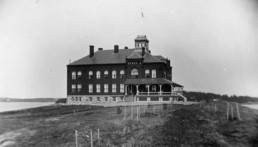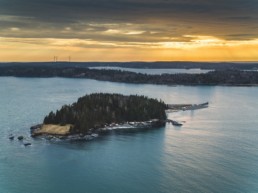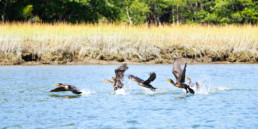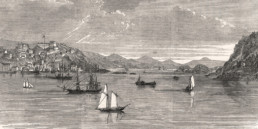Widow’s Island: A Curious Tale of Quarantine and Convalescence
Yellow fever, mental illness, and war wounds treated on island off North Haven.
By Carl Little
Photos by WILLIAM TreVASKIS
Back in the 1970s when I lived on Long Island, New York, I had occasion to take the ferry from Orient Point to New London. I remember passing Plum Island and being told there was a center for disease research on it. Visions of infected patients wandering the island gave me the creeps. In fact, the facility, founded in 1954 and now under the aegis of Homeland Security, has focused on the study of foot-and-mouth disease in cattle. Area residents have never fully embraced its existence, and have even come up with a theory that Lyme disease was created there as a biological weapon, but escaped the island.Seagoing folk passing by Widow’s Island in the late 1800s might have gotten similar vibes. This 15-acre isle off the eastern shore of North Haven, one of several flanking the Fox Islands Thoroughfare, was home to a quarantine station built by the US Navy to house sailors returning from foreign ports, Panama in particular, who had contracted yellow fever.
Why Widow’s? Colder climates were thought to aid in the recovery from the deadly virus, which is transmitted by infected mosquitoes, a fact doctors didn’t know at the time. With the quarantine station in Portsmouth, New Hampshire, “antiquated and played out,” this island seemed like a perfect spot to isolate victims while they recovered.
So the US Navy had procured Widow’s and built a temporary hospital—a pavilion—in 1885, and then, in 1888, a permanent facility, an imposing two-story brick building that could accommodate fifty patients. Both structures were built by W. H. Glover & Co. of Rockland.
Area citizens were none too pleased to have this possible source of contagion in their backyard; a “remonstrance” expressing their concerns was circulated on North Haven and Vinalhaven in 1885. The Courier-Gazette of May 12 of that year stated, “The people in the vicinity have no cause for alarm,” noting that at Portsmouth, “rusticators have built their cottages right down to the quarantine line, and have no fear of contagious diseases, [even] though two yellow fever vessels were anchored there last year.”

The hospital, ca. 1888. (Courtesy North Haven Historical Society)
Dr. A. C. Heffinger, the naval surgeon put in charge of the project, helped sell the idea, inviting “leading citizens” of Rockland to the island for tours of the facility. In the end, they needn’t have worried. The complex never actually housed any yellow fever patients, thanks to new knowledge about the malady.
A bit of history: In his Islands of the Mid-Maine Coast: Blue Hill and Penobscot Bays (1983), Charles McLane offered an account of the island’s habitation. Originally called Sheep Island on John Vinal’s map of the area, Widow’s was a part of the Winslow Farm on North Haven, its Addams Family-esque name honoring Josiah Winslow’s wife, who spent nearly a half-century in widowhood.
Deemed unnecessary as a quarantine station, on January 1, 1904, the facility was transferred by the US government to the State of Maine to be used as a summer retreat for the “convalescent insane.” For the next ten years, local islanders witnessed the comings and goings of groups of men and women from the Maine Insane Asylum in Augusta and Bangor.
In an article in the Courier-Gazette from fall 1971, Rockland resident Albert Mills Sr. shared memories of the facility from when he worked there during the summers of 1909 and 1910. By this time, the island’s name had been changed to Chase’s, in honor of Judge Edward Everett Chase of Blue Hill. According to McLane, it was Chase, a trustee of the Maine State Mental Hospitals, who had urged the transfer of the Widow’s Island hospital to the state. The facility came to be called the Chase Island Convalescent Hospital.
The son of the keeper of nearby Goose Rocks Light, Mills had been hired by Manning S. Campbell, treasurer of the Maine State Hospital, to be the on-site engineer. With help from the keeper, Captain Frank Cooper, he took care of the water and electricity, no mean feat in this remote outpost. He also serviced the boats, which included the whim, a small open launch, and the 40-foot schooner general knox, which carried patients and personnel on cruises around the islands. In that 1971 article, Mills described a picnic on Vinalhaven during which a female patient disappeared and was found hours later at the North Haven post office.
Mills described the grounds, which featured trees planted in 1885 by officers of the 127-ton naval tugboat rocket, in order to make the property less destitute. (In photos of the era, only a few spruce trees accent the sheep-shorn island; today, it is more or less covered in evergreens.) A large swimming pool built near the shore could be filled with seawater at high tide and then shut off to be warmed by the sun. “It gave the patients a nice change and [a] summer vacation,” Mills wrote.

Reading excerpts from the diaries of Dr. Bigelow Sanborn (1839–1910), physician at, and then superintendent of, the Maine Insane Asylum from 1866 until his death, one realizes that the challenges of dealing with mental illness in Maine go back generations. Transcribed by Sanborn’s granddaughter, Margaret Hodgdon, the diary mentions issues familiar to anyone following the current tribulations of the Department of Health and Human Services: lack of funding, deferred maintenance, a sometimes stingy legislature, and a scrutinizing press.
There are touches of Cider House Rules in Dr. Sanborn’s reports. Outbreaks of diphtheria and la grippe, snowstorms, residents setting fire to beds, physicians abusing alcohol and morphine—the accounts are matter-of-fact but often startling. Not all is disaster control: the Togus minstrels and the Augusta Brass Band performed for the patients, and there were magic lantern shows and picnics.
The name “Widows Island” (without the apostrophe) appears for the first time in entries for 1905. Following a visit by Dr. Sanborn, his wife, and hospital trustees to inspect the facility, the Maine Insane Asylum began taking patients to the island in the summer and fall.
“On August 4,” the superintendent reported, “I went down to Widows Island with 28 females and took back the males.” Dr. Sanborn noted the mostly positive impact of this retreat in his diary. He already knew the beneficial effects of a Maine island on patients: In the 1890s he organized annual trips by steamboat to his summer home on the Isle of Springs.When “Mr. Chase’s experiment” closed in 1915, historian McLane recounted, the facility was for a short time repurposed as a school for the children of lighthouse keepers. During World War I, US Navy sailors came to the island to convalesce from injuries and illness.
The hospital was torn down in 1935 “as a WPA project.” An April 1986 article in Down East magazine, with the somewhat sensational title “Widow Island’s Tainted Past,” noted that the bricks from the building “found their way into fireplaces on nearby Vinalhaven, and the rest were used to weight lobster traps in Penobscot Bay.” The island became a bird sanctuary, and then, writes McLane, the summer home “of a vacationing realtor.”
A fitting finale to this curious piece of Maine island history might be the last stanza from Mary W. Litchfield’s poem, “Governor’s Day at Widow’s Island,” written on September 5, 1905, and inspired by the visit of former Maine governor Frederick Robie and other dignitaries, including Judge Chase, to the island. As the sunset lights up the Camden Hills and drives “grief and gloom away,”
All too soon the party leaves us,
Pleasant guests, though short their stay,
Long by us will be remembered
Widow’s Island’s gala day.
Thanks to Jason Mann, and to Nan Lee, John Storck, and Kate Quinn at the North Haven Library and Historical Society, for providing background and photographs.






